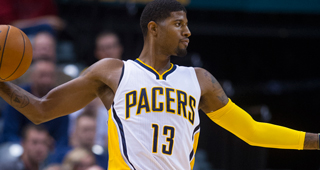During last year’s first-round series between the Toronto Raptors and Indiana Pacers, Paul George decided to remind people why all 30 NBA general managers try so desperately to collect superstar talent.
In nearly beating a 56-win team by himself, George shut down their leading scorer and was virtually unstoppable with the ball, averaging 27.3 points, 7.6 rebounds, and 4.3 assists in a seven-game series that could’ve easily ended in victory for the No. 7 seed Pacers. George’s efficiency was cruel with a True Shooting Percentage of .632. He sparkled on a big stage and held the air of a franchise cornerstone.
Today, things are a little different. George is still a very good player who deserves an All-Star nod. Indiana’s offense doesn’t function when he isn’t on the floor and its defense loses a step. He’s never shot the ball better, is currently one of the most reliable clutch scorers walking, and his (very few) defensive issues are more mental than physical. But while most players of his stature see raw numbers rise at this stage of their career, most of George’s are either stagnant or dropping—a mild concern considering he’s only 26.
But before we dig into his game, it’s only fair to acknowledge how certain factors outside George’s control might’ve stunted his growth. It’s not his fault Larry Bird decided to swap the forever-underappreciated George Hill for Jeff Teague, a speedy point guard whose former team couldn’t wait to replace him. Or surround him with a space-eating dinosaur and ineffective outside shooting (Thaddeus Young has been better than expected, but 43 percent from beyond the arc is an aberration).
Every star needs complementary pieces who draw their best effort out while also simplifying their responsibilities, but it’s still so difficult to make excuses for the best of the best. A five-game win streak has Indiana back on the right side of playoff contention, but they’re far from guaranteed to make it.
And that’s where George has been a disappointment. Heading into this season, off a stellar showing at the Olympics, George was deservedly pegged as the Eastern Conference’s second-best player. He was a darkhorse MVP candidate and viewed as plenty able—despite obvious deficiencies in the new roster—to lift his team above and beyond baseline competence (which the Pacers are still searching for).
Amid Indiana’s relative struggle, George is his most efficient self; the addition of several offensive-minded players has removed the ball from his hands. But subtle signs of decline may be creeping into the frame. His free-throw and assist rates are both down—the latter fails to rise even when Teague isn’t on the floor—and has never been a worse rebounder.
Three seasons ago, 20.8 percent of George’s shots came within three feet of the basket. This year that number is all the way down to 13.7 (the lowest of his career), and his relationship with mid-range jump shots has taken a disturbingly favorable turn. Take a look at the two charts below.
Long story short: His jump shot has undoubtedly improved—especially from deep—but he isn’t attacking the basket as often as he used to. Beyond Indy’s cramped spacing and the devastating leg injury George suffered two summers ago, is there a logical explanation for this shift in shot distribution?
George almost exclusively plays small forward, even though the Pacers obliterate opponents in those rare blips when he’s a small-ball four. That’s one issue, and he spent a lot more time playing up a position last season. But there’s more.
George has always leaned on the pick-and-roll to find production, but he’s shown little to no evolution in the post, an area that could unlock so many options for Indiana’s offense. Whenever he does attack down low, George A) is almost always matched up against a smaller defender, and B) quickly shoots over the top instead of forcing help and getting his teammates a quality look.
George finished last season ranked 13th in Real Plus-Minus. Right now, he’s at 47. He also scored at least 30 points in 26 percent of his games. So far, this year he’s only done it five times (aka 16 percent).
Let’s compare him to other stars around the conference. Is George even the second-best wing? Is he having a better year than Giannis Antetokounmpo or Jimmy Butler? Is he more offensively imposing than Isaiah Thomas, John Wall or Kyle Lowry?
It’s almost unfair to take a two-month sample size and rearrange this sort of pecking order, but it’s also clear that George hasn’t played as well as several players he used to look down on. It’s more likely than not he doesn’t make an All-NBA team, either, which means the Designated Player Exception won’t be available until the following summer, when he’s an unrestricted free agent.
That puts the Pacers in a sticky situation. Do they trade away one of the NBA’s 20 best players and rebuild around Myles Turner with a hoard of lottery picks, or gamble on George’s return to All-NBA form in 2017-18 and risk losing him for nothing? It’s an incredibly difficult position for that front office to be in, and my guess is they’ll wait until the 2018 trade deadline before seriously considering any offers.
If he makes the type of leap Butler has this year, maintains his efficiency and doubles his trips to the free-throw line, an All-NBA spot will be in the cards and Indiana can exhale knowing George will have to surrender a ridiculous amount of money if he wants to leave.
If not, the Pacers will have to ask themselves if their superstar draw is actually that.



